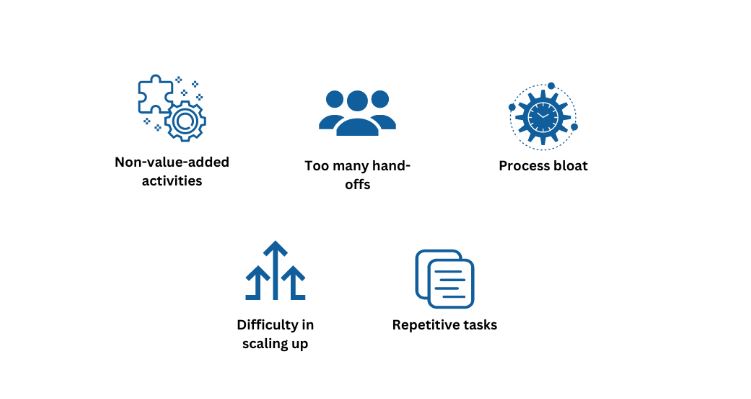Business process reengineering: the path to maximum efficiency

Source: Canva
To be competitive in today’s fast-changing business environment, companies must continually increase efficiency. Reengineering workflows and business processes may help accomplish this. Business process reengineering is a company management technique that analyzes and redesigns workflows and processes. It completely restructures company operations to increase quality and improve costs, service, and speed.
In the early 1990s, BPR was introduced to identify, evaluate, and restructure an organization’s essential business processes to eliminate redundancies, reduce mistakes, and boost efficiency. It rigorously analyzes, rethinks, and redesigns mission-delivery processes. Business process improvement (BPI) differs from BPR. The latter rejects rules and revamps processes from a high-level viewpoint, unlike BPI, which only makes incremental adjustments.
Identifying the triggers for BPR

Figure 1. BPR Triggers | Source: Adapted from LinkedIn
Businesses may realize the need for BPR when they observe certain signs that indicate inefficiencies or bottlenecks in their current processes. Here are some key indicators that suggest a business might benefit from BPR:
- Non-value-added activities: These are tasks or processes that do not add value to the business or its customers.
- Too many hand-offs: Processes involving too many hand-offs or transfers between different departments or individuals can lead to delays and miscommunication.
- Process bloat: Overly complex or bloated processes can slow down operations and reduce efficiency.
- Difficulty in scaling up: This occurs when a business struggles to scale its operations due to inefficient or poorly integrated systems.
- Repetitive tasks: These are characterized by employees finding themselves doing the same thing repeatedly, especially tasks that could be automated.
Read More: The power of change management in strategy execution
BPR best practices
- Process mapping: This involves defining the scope, purpose, and goal of the project, and then mapping out the sequence of tasks or steps that are performed to achieve a certain goal or outcome. This can help identify gaps, redundancies, bottlenecks, delays, errors, and rework in the workflow.
- Analyzing current processes: This involves reviewing the current workflows and processes to identify inefficiencies and areas for improvement. This includes looking for common inefficiencies such as overproduction, waiting, transportation, overprocessing, and motion.
- Identifying redundancies: Redundancies are any processes, procedures, roles, reports, meetings, or other business activities that are duplicative, outdated, or otherwise unnecessary. Once these are identified, they can subsequently be eliminated.
- Using workflow analysis tools: Workflow analysis tools can help visualize, analyze, and improve business processes. These tools can identify inefficiencies, streamline operations, and automate manual tasks.
- Implementing automation: Workflow automation tools can help streamline routine business processes for optimal efficiency. These tools can reduce busy work and optimize processes, allowing employees to focus on more important tasks.
Benefits of BPR
- Improved collaboration: Optimized processes, particularly those that are automated, provide a centralized system for tracking tasks and sharing data. This shared access to information can improve collaboration among departments, reducing the risk of miscommunication and errors.
- Enhanced productivity: Process optimization can lead to significant increases in operational efficiency. By streamlining processes and automating routine tasks, employees can work more effectively and deliver quality work in a timely manner.
- Empowerment: Reengineered processes often involve redistributing power and authority among functions and levels, empowering individuals to think, interact, use judgment, and make decisions. This fosters innovation and creativity among employees, leading to better solutions to problems and faster problem-solving times.
- Innovation and creativity: Integrating innovation and creativity into the reengineering process can lead to more effective and sustainable process improvements.
Read More: How businesses make use of disruptive innovation to adapt to change
Case study: Domino’s
In 2008, Domino’s stock price hit an all-time low, rendering it nearly bankrupt. The transformation began with a complete overhaul of its ingredients, recipes, and menu, but the real game-changer was its focus on digital transformation.
Domino’s focused on three key areas for its digital transformation: customer experience, data analytics, and technology infrastructure. The company implemented a unified digital platform that integrated online ordering, customer feedback, and delivery tracking.
One of the most significant steps in this transformation was the introduction of the “Pizza Tracker” technology in 2008, which kept customers updated on the progress of their orders. This innovation, along with others, changed the brand perception of Domino’s from a pizza delivery company to a technology-driven company.
By 2018, Domino’s overtook Pizza Hut as the largest pizza delivery company globally, with a market share of 18.6%. The company’s revenue grew from $1.4 billion to $3.5 billion, and its net income increased significantly. The company’s stock price also saw a dramatic increase, from around $3.00 a share in 2008 to $211 in 2018-2019.
In conclusion
BPR is a critical component of any organization’s quest for maximum efficiency. By identifying and eliminating inefficiencies, streamlining processes, and fostering a culture of continuous improvement, organizations can successfully reengineer workflows, enabling them to stay competitive in today’s rapidly changing business landscape.
For more insightful articles on organizational performance and other similar concepts, click here.

